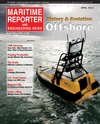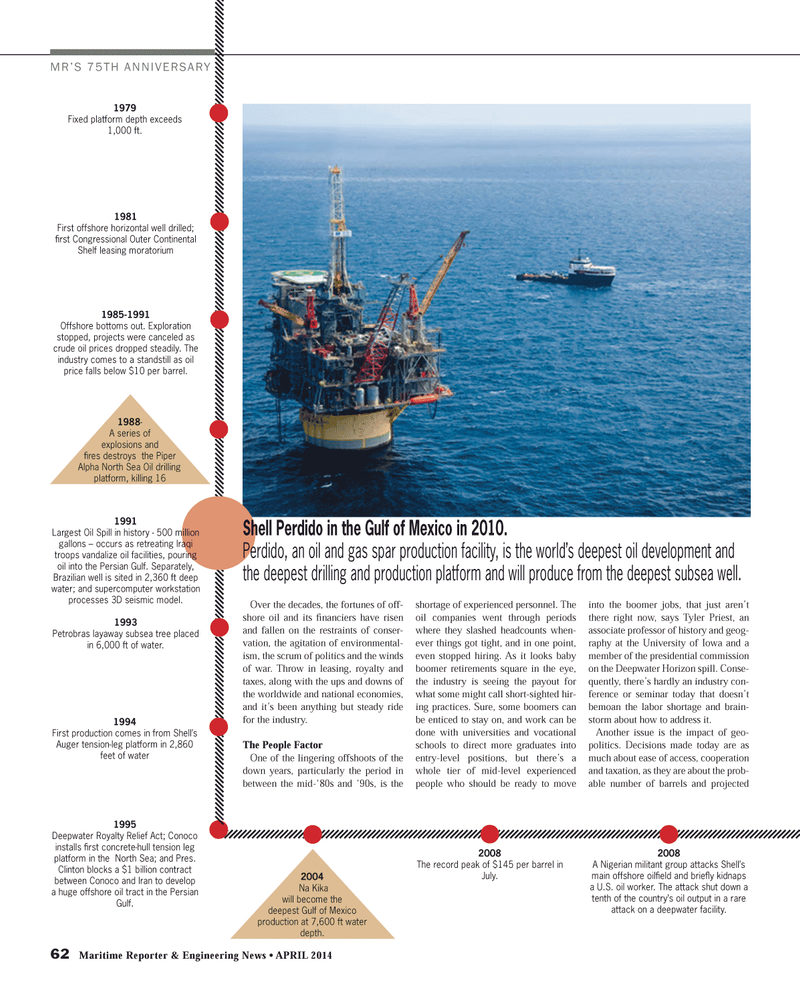
Page 62: of Maritime Reporter Magazine (April 2014)
Offshore Edition
Read this page in Pdf, Flash or Html5 edition of April 2014 Maritime Reporter Magazine
62 Maritime Reporter & Engineering News ? APRIL 2014 MR?S 75TH ANNIVERSARY Over the decades, the fortunes of off- shore oil and its Þ nanciers have risen and fallen on the restraints of conser- vation, the agitation of environmental-ism, the scrum of politics and the winds of war. Throw in leasing, royalty and taxes, along with the ups and downs of the worldwide and national economies, and it?s been anything but steady ride for the industry. The People FactorOne of the lingering offshoots of the down years, particularly the period in between the mid-?80s and ?90s, is the shortage of experienced personnel. The oil companies went through periods where they slashed headcounts when-ever things got tight, and in one point, even stopped hiring. As it looks baby boomer retirements square in the eye, the industry is seeing the payout for what some might call short-sighted hir- ing practices. Sure, some boomers can be enticed to stay on, and work can be done with universities and vocational schools to direct more graduates into entry-level positions, but there?s a whole tier of mid-level experienced people who should be ready to move into the boomer jobs, that just aren?t there right now, says Tyler Priest, an associate professor of history and geog-raphy at the University of Iowa and a member of the presidential commission on the Deepwater Horizon spill. Conse-quently, there?s hardly an industry con- ference or seminar today that doesn?t bemoan the labor shortage and brain-storm about how to address it. Another issue is the impact of geo-politics. Decisions made today are as much about ease of access, cooperation and taxation, as they are about the prob-able number of barrels and projected 1995Deepwater Royalty Relief Act; Conoco installs Þ rst concrete-hull tension leg platform in the North Sea; and Pres. Clinton blocks a $1 billion contract between Conoco and Iran to develop a huge offshore oil tract in the Persian Gulf. 2004 Na Kika will become the deepest Gulf of Mexico production at 7,600 ft water depth. 2008The record peak of $145 per barrel in July. 2008A Nigerian militant group attacks ShellÕs main offshore oilÞ eld and brieß y kidnaps a U.S. oil worker. The attack shut down a tenth of the countryÕs oil output in a rare attack on a deepwater facility. 1979Fixed platform depth exceeds 1,000 ft.1981First offshore horizontal well drilled; Þ rst Congressional Outer Continental Shelf leasing moratorium1985-1991Offshore bottoms out. Exploration stopped, projects were canceled as crude oil prices dropped steadily. The industry comes to a standstill as oil price falls below $10 per barrel. 1988- A series of explosions and Þ res destroys the Piper Alpha North Sea Oil drilling platform, killing 161993Petrobras layaway subsea tree placed in 6,000 ft of water. 1994First production comes in from ShellÕs Auger tension-leg platform in 2,860 feet of water1991Largest Oil Spill in history - 500 million gallons Ð occurs as retreating Iraqi troops vandalize oil facilities, pouring oil into the Persian Gulf. Separately, Brazilian well is sited in 2,360 ft deep water; and supercomputer workstation processes 3D seismic model. Shell Perdido in the Gulf of Mexico in 2010. Perdido, an oil and gas spar production facility, is the worldÕs deepest oil development and the deepest drilling and production platform and will produce from the deepest subsea well. MR #4 (56-65).indd 62MR #4 (56-65).indd 624/7/2014 3:16:15 PM4/7/2014 3:16:15 PM

 61
61

 3rd Cover
3rd Cover
